J. A. THOMSON, building contractor 1835-1857
J. A. THOMSON, Hobart City Alderman and Captain GOLDSMITH 1853
Captain Edward GOLDSMITH's twin ferry Kangaroo, costs and critics 1856

Detail, left image of stereograph of the pile bridge over River Derwent at New Norfolk, with male figure hiding his face seated in immediate foreground on the right of each single image.

Pile bridge at New Norfolk built by James Alexander Thomson (1840-41).
Residence of Mr W. Sharland Esq, Woodbridge, visible to the right of bridge in distance across the River Derwent.
Stereograph on arched buff mount by Thomas J. Nevin ca. 1868
Tasmanian Museum and Art Gallery Collection
TMAG Ref: Q16826.16
Biography
From: The Australian Dictionary of Biography online
https://adb.anu.edu.au/biography/thomson-james-alexander-2733
James Alexander Thomson (1805-1860), architect, engineer and building contractor, was a native of Haddington, Scotland, and at 20, as 'a wild but clever young man', was transported to Van Diemen's Land for theft. With his brothers William and Joseph he had been discovered in a private house, and the three were tried together for the same offence and sentenced on 18 February 1824. William was considered less culpable and pardoned after imprisonment in Newgate; Joseph and James were transported separately; Joseph, who identified the object of the theft as jewellery to the value of £3000, was drowned after two years in the colony. James, who arrived at Hobart Town in the Medway on 14 December 1825, was assigned to public works and was frequently on loan to the colonial architect, David Lambe, and his successor, John Lee Archer, both of whom professed satisfaction with his work as draughtsman. Archer procured for him a small remuneration and towards the end of his assignment he was superintendent of the church building at Richmond (St Luke's 1834-37). He had also acted from 1830 as overseer of the government plumbers, glaziers and painters; indeed his trade was given in convict records as decorative painter. These records imply that at the date of transportation he had a wife and child living in Park Street, Regent's Park, London. By 3 June 1830, however, he had petitioned the lieutenant-governor for permission to marry Eliza Ogilvie, the comfortably endowed widow of a respectable Hobart wine and spirits merchant who had died in 1828 leaving her with three children. A daughter, Alice, appears to have been born on 7 August 1830, although the marriage at Richmond did not take place until 16 October 1832. A son, William, was born on 13 August 1833. By 1859 only one daughter, Fanny, survived, but two sons were living.Source: https://adb.anu.edu.au/biography/thomson-james-alexander-2733
Thomson received a conditional pardon on I January 1835 and immediately set up a business in Liverpool Street, which lasted for most of his life, not only as architect, engineer and surveyor, but also as valuer, estate agent, map printer and dealer in machinery. His free pardon became effective on 31 July 1839. Despite his several complaints that officers of the Royal Engineers and public servants used their leisure time in architectural activities and caused unfair competition, Thomson seems to have enjoyed reasonably consistent architectural patronage, particularly during the shortage of architects in the 1840s. In 1841 he was a partner of James Blackburn in at least some contracts, though both worked independently as well. Thomson was also one of the first in Hobart to become interested in lithography both in its artistic and in its commercially reproductive applications. In 1850-51 Thomson had been one of the first to seek gold in Tasmania, investigating without success Frenchman's Cap and other areas. On 5 December 1852 his wife Eliza died, aged 51, and on 6 December 1853 Thomson married Catherine, the widow of the Hobart builder, John Jackson. Thomson moved from Liverpool Street to Elboden Street and later to Melrose in Hampden Road. He owned property in Macquarie Street, and worked professionally from the Stone Buildings later, about 1855-56 operating there under the name of Thomson & Cookney.
In 1853 he yielded to the supplications of a large group of supporters to stand as an alderman on the Municipal Council, a position he held until 1857. One of his great concerns was the Hobart water supply. Architecturally the bulk of Thomson's work appears to be in the domestic context: the designing and sometimes building of workmanlike utilitarian structures such as shops, office buildings, terraces and houses and cottages, none being works of paramount importance. One interesting tender let in 1850 was for fifty timber-framed houses for the Californian goldfields. Thomson was also engaged in contracting for jetties, wharves and harbour improvements in Hobart and, with Blackburn, road-making. His spectacular buildings were few. Unquestionably the most interesting and important work is the Hobart Synagogue (1843-45), the most comprehensive example of the Regency Egyptian style in Australia (felt suitable for this religion), surpassing in quality the first synagogues of Launceston, Melbourne and Sydney. Other churches are of plain and rudimentary village Gothicism, such as St Joseph's, Hobart (1841-43, some alterations), and St Joseph's, Launceston (1838-42, demolished and replaced), little touched by the more scholarly aspects of Gothic Revivalism. A few other works are attributable. Besides the Bridgewater Bridge (1846-49, with Blackburn) Thomson's best known early work was the pile bridge across the Derwent at New Norfolk (1840-41). An association with the stone bridge at Dunrobin (built 1850-56 under William Kay's supervision) is suggested by an obituary of reserved eulogies, which lists also the bridge at Richmond (presumably reconstruction of earlier fabric), the smelting works at Exmouth Bay, the former Hobart Exchange rooms and attorney-general's offices. Thomson had a long record of devoted service as a Freemason and Lodge treasurer, and committee member of the Hobart Mechanics' Institute. He sailed in the Isles of the South on 3 February 1860 for a visit to England, and died of typhoid fever at Helensburgh, near Glasgow, on 15 September 1860, aged 55.
Whatever his merits as architect, and they are relatively minor, Thomson provides a remarkable case of a former convict establishing himself as a successful businessman, despite his small estate, respected in many circles and with a considerable variety of commercial activities and social interests.
Select Bibliography
Hobart Town Advertiser, 21 Nov 1860, Blackburn papers (privately held).
Citation details: Harley Preston, 'Thomson, James Alexander (1805–1860)', Australian Dictionary of Biography, National Centre of Biography, Australian National University, https://adb.anu.edu.au/biography/thomson-james-alexander-2733/text3857, published first in hardcopy 1967, accessed online 13 September 2021.
This article was published in hardcopy in Australian Dictionary of Biography, Volume 2, (Melbourne University Press), 1967
J. A. Thomson:
Transportation Records - arrival at Hobart, 1825
Born 1805
Occupation: Painter & glazier
Date of Death: 15th September, 1860
Age: 55 years
Crime: Theft
Convicted at: Aberdeen Court of Justiciary
Sentence term: 14 years
Ship: Medway
Departure date: 28th July, 1825
Arrival date: 14th December, 1825
Place of arrival: Van Diemen's Land
Passenger manifest: Travelled with 172 other convicts
References
Primary source: Australian Joint Copying Project. Microfilm Roll 88, Class and Piece Number HO11/5, Page Number 293 (148)
Secondary source: https://convictrecords.com.au/convicts/thomson/james-alexander/108662
Hobart Town Gazette, 15 Sept 1827
List of Runaways
331. Thompson, James, alias Coutts, 5 ft. 4, brown hair, blue eyes, aged 23, flax dresser, tried at Aberdeen, April 1825, sentence 14 years, per Medway 2, native of Kinnear, absconded from service of Mr. French, in January last. Same reward. (£2).
Architecture by or attributed to James A. Thomson
Are they Scottish buildings?
Thomson arrived in Van Diemen’s Land as a convict, found guilty of theft and transported in 1825. In 1827, his qualifications—recorded as a decorative painter—saw him assigned to the Office of the Colonial Architect & Engineer (established in 1827, following the appointment and arrival of the incumbent John Lee Archer) from 1827 to 1832, prior to practicing variously as an architect, engineer, surveyor and builder (independently and in partnerships) through to the 1850s. He was one of a handful of practicing architects in the period. Whilst designing in a range of picturesque styles, the mainstay of Thomson’s practice was an austere Grecian mode realised across a variety of villas, commercial, and ecclesiastical buildings in the 1830s and 1840s (fig. 9). From Haddington, just outside of Edinburgh, and likely trained in the 1820s, Thomson would no doubt have absorbed the consolidation of the Greek Revival as an almost “national style” in Edinburgh as it was being re-imagined as the “Athens of the North” in the 1820s.Source: Scottish Networks and their Buildings in Van Diemen’s Land and Tasmania
Excepting considerations of his impressive Egyptianate Hobart Synagogue (1843-1845), the jury is out on the architectural merits of Thomson’s work and his reputation, historiographically, which falls back to his professional redemption from convictism. One of the problems of the narrative is that it circumvents full consideration of Thomson’s Scottish heritage and its potential implications for his career. Unexamined is the extent to which Thomson’s Scottish background, identity, and associated networks supported his success in practice and, in the process, inflected an emergent architectural discourse in the colony.
Author: Stuart King
Link:https://journals.openedition.org/abe/5887
Link: https://doi.org/10.4000/abe.5887
1831-1836: Wentworth House, Bothwell, Tasmania
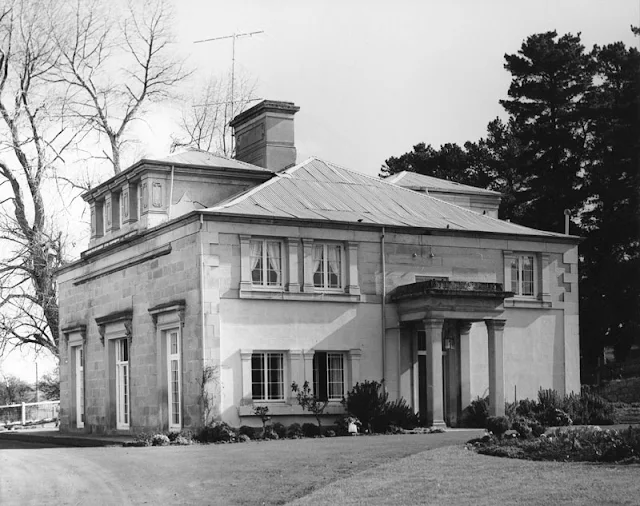
Wentworth House, Bothwell, Tasmania, built c.1831-36. Photograph by Sir Ralph Wishaw, 1966.
Source: Hobart (Australia), Tasmanian Archives and Heritage Office, Whishaw Collection, NS165/1/31
1841: St Joseph’s Catholic Church, 165 Macquarie St, (cnr Harrington St) Hobart, the oldest Catholic church in Hobart; Gothic Revival style.
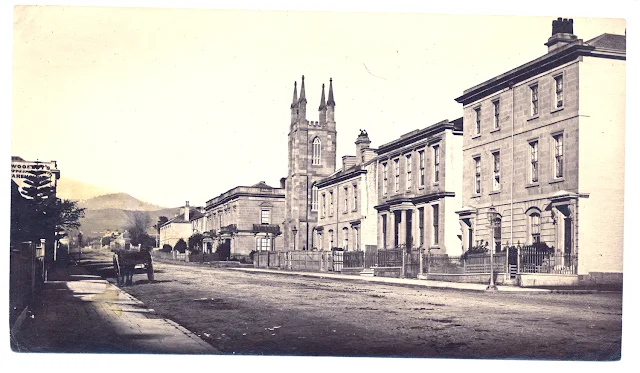
Macquarie Street Hobart, looking west to St. Joseph's Catholic Church c. 1870
Photographer: Henry Hall Baily
Source: https://eprints.utas.edu.au/2618/
1843-1845: The Synagogue, 59 Argyle St, Hobart. Egyptian revival style, Australia’s first Synagogue
A single storey building designed by James Thomson, it is the oldest place of Jewish worship in Australia. It is a rare example of Regency Egyptian Revival style.
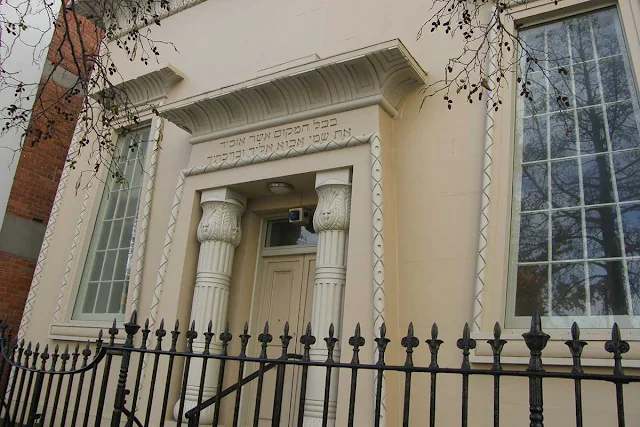
Hobart Synagogue, Argyle Street, Hobart, Tas.
Source: https://www.ourtasmania.com.au/hobart/hobart-heritage-walk.html
1846: Tasmania Club, 132 Macquarie St Hobart.
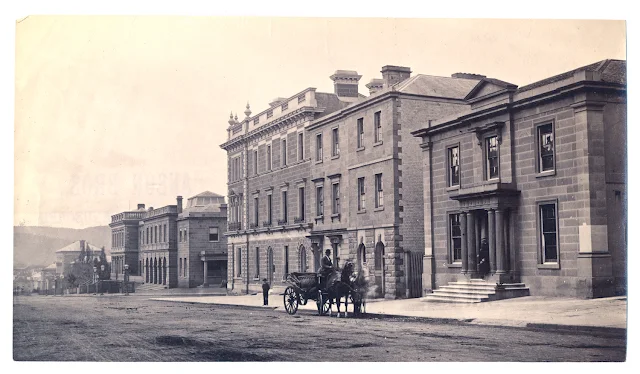
The Tasmanian Club, Macquarie Street, Hobart, Tasmania c. 1880
Photographers: Anson Brothers, Liverpool, Collins and Elizabeth Streets between 1878 and 1891.
Source: https://eprints.utas.edu.au/2655/
This photograph shows the Tasmanian Club, Walch's, Derwent and Tamar Assurance Company, Post Office, Supreme Court, Franklin Square, Town Hall, Museum and Pregnell's butcher shop in Macquarie Street, Hobart ca. 1875. The Georgian style building was designed by architect James Alexander Thomson and built in 1846 for banker and merchant Captain Charles Swanston at the Derwent Bank which went into liquidation during the depression of the 1840's. The Tasmanian Club was established in 1861 in Hobart by seventy men. It was founded on the 'London pattern', that is, election or exclusion of candidates by ballot. The Club relocated to leased premises at Webb's (now Hadley's) Hotel in Murray Street from 1861 until 1873 when they purchased the Macquarie St. building. It is still used as their residence today. In 1891, following outright purchase of the land and buildings, major extensions were made to the Club building, including the main dining room and accommodation. The Tasmanian Club is regarded as the 'senior gentlemen's club' of Tasmania by its interstate and overseas counterparts. It has an upper limit to membership of 400.
Further reading: F Green, The Tasmanian Club, Hobart, 1961.
Source: https://www.utas.edu.au/library/companion_to_tasmanian_history/T/Tas%20club.htm
1847: formerly Franklin Chambers, 105 Macquarie St, Hobart.
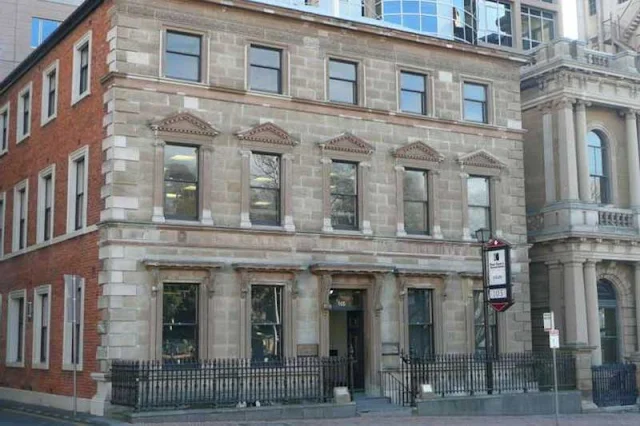
Mercantile Mutual Building, Franklin Chambers, 105 Macquarie Street, Cnr. Trafalgar Place, Hobart, Tas. A three storey Victorian era Academic Classical commercial building, designed by J. A. Thomson with a front facade in ashlar, the rest in brick and a hipped iron roof. There are expressed quoins, bracketed cornices to ground floor openings, Ionic pilasters and pediments to second level windows, string courses, a decorative frieze and a cornice to the roof.Source: https://www.ourtasmania.com.au/hobart/hobart-heritage-walk.html
1848: "Hildern” (St James’ Rectory) 29 August Rd, New Town.
'Hildern' was built in the late 1840s for David Heckscher, a watchmaker and jeweller. Heckscher got into financial difficulties and had to sell the property to repay his debts. John James (c1794-1863), a wine and spirit merchant, bought 'Hildern' in 1850 and over the next forty years it was rented out to various tenants. William Gilchrist Watt (c1840-1914) bought the property in 1893. Watt lived at 'Hildern' until his death at which time the property passed to his wife, Catherine. Catherine paid for the construction of St James the Apostle Church which is located a few hundred metres away on the corner of Elizabeth Street and Rupert Avenue. The Church was dedicated in the memory of William Gilchrist Watt by the Bishop of Tasmania in 1918.Catherine died in 1919 and bequeathed Hildern to the Church of England in Tasmania as the Rectory for St James'. Hildern remained the Rectory for St James' for over sixty years until the 1980s when the Church could no longer afford to maintain it. The Tasmanian Government had to pass legislation - the Church of England (Rectory of St James the Apostle) Act 1980 - to allow the Church to sell the property.It would appear that the building and its accompanying stone barn are still in private hands to this day and appears to be undergoing restoration and conservation of the buildings and grounds.Source: Photo and text G. Ritchie
Link: https://ontheconvicttrail.blogspot.com/2014/05/hildern.html
Main Information & Text Source – Australian Heritage Database
Other buidings possibly by James Thomson:
St Andrew’s Evandale has not previously been attributed to James Thomson. It is proposed here on the basis of connections within the Presbyterian church and the re-iteration of the same pattern book source.
St Andrews Uniting Church, Evandale
Source: Copyright photo and text - G. Ritchie, "no architect has ever been identified..."
Link: https://ontheconvicttrail.blogspot.com/2017/10/st-andrews-uniting-church-evandale.html
1853: Captain Goldsmith's vote for James Thomson
In 1853 ahead of the launch of his twin ferry Kangaroo, Captain Goldsmith foresaw the need for suitable wharves on either side of the River Derwent - at Bellerive (Kangaroo Point) and at Hobart - where carriers could load and unload passengers and cartage safely. Those wharves would be a key factor in the ferry's success. Needing the right candidate in the 1853 Hobart City Council aldermanic elections who could realize the sort of wharf construction he envisaged, he put his support behind building contractor James Alexander Thomson.
TRANSCRIPT
MUNICIPAL ELECTION.Source: MUNICIPAL ELECTION (1853, December 13). Colonial Times (Hobart, Tas. : 1828 - 1857), p. 2.
NOMINATION OF CANDIDATES.
THE nomination of candidates to fill the seat in the Municipal Council, rendered vacant by the absence of Mr. Oldham, took place, yesterday, at noon, in the New Market.
Mr. T. J. CROUCH officiated for the Sheriff, and having read the authority under which he noted, called upon some elector to propose Mr. Murphy, who had been first in the field.
Mr. E. H. COLE had " much pleasure" in proposing Mr. Dennis Murphy, as "is fit and proper person," etc.
Mr. JOHN MOORE: seconded the nomination, ASKIN MORRISON, Esq., M.L.C., proposed Mr. J. A. Thompson [sic - Thomson] as a candidate, for the vacant office.
Capt. GOLDSMITH, in seconding the nomination, drew attention to Mr. Thompson's [sic] professional experience, as a qualification of which his opponent could not boast.
Mr. MURPHY, who is no "stump-orator," briefly thanked his supporters, and expressed a hope that by four o'clock next day they would place him at the head of the poll.
MR. J. A THOMPSON [sic] also'briefly'acknowledged the kindness and zeal with which he had been supported. Captain Goldsmith had kindly expressed an opinion that his (Mr. Thompson's [sic - Thomson's] professional knowledge might be serviceable to the city, and he assured them, that if elected, his services should be ever at the command of the corporation. Mr. Thompson [sic] proceeded to show that he had been engaged both by the commissioners and the present corporation to prepare the assessments of the city, and, as a proof of the correctness of his judgment in such matters, he stated that although there were 4000 separate assessments in one case, and 4500 in the other, there had been only 10 appeals in the first instance, and 7 in the second. The electors might therefore place some confidence in his professional knowledge. Having stated that neither his committee nor himself had entered the contest with any ill feeling, he proceeded to allude to some offensive placards which had been issued by his opponent. In one of these it appeared it was insinuated that he would help to increase taxation from self-interested motives ; but he assured them that, having a considerable stake in the city, his " self-interest" consisted in reducing taxation, for in increasing it he taxed himself. He again thanked them for their support hitherto, and asked them for their votes on the morrow.
Mr. Crouch then declared that the poll would be taken in the New Market THIS DAY, Commencing at 9 a.m., and closing at 4 p.m. The meeting then separated.
Link: https://nla.gov.au/nla.news-article8774990
1856: Captain Goldsmith's twin ferry "Kangaroo"
Public opinion was divided on the cost and performance of the vehicular steam ferry Kangaroo which was built by Elizabeth Rachel Nevin's uncle Captain Edward Goldsmith in 1854-1855. It was sold to Askin Morrison in 1857, then to James Staines Taylor in 1864 who operated it for the next 40 years. It was still in operation well into the first decades of the 20th century despite the many complaints about its unwieldyness. Bought by the O'May Bros in 1903, its service was terminated in 1925 and replaced by the Lurgerena in 1926.
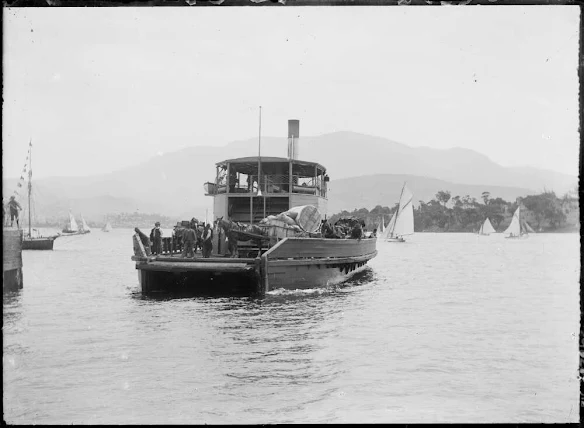
Creator Searle, E. W. (Edward William) 1887-1955
Title S.S. Kangaroo, Hobart to Bellerive ferry, Hobart, ca. 1913 [picture] / E.W. Searle
National Library of Australia: Link: https://nla.gov.au:443/tarkine/nla.obj-141891637
This lengthy article published in Tasmanian Daily News, 12 July 1856, was typical of the criticism levelled at Captain Goldsmith and the twin ferry Kangaroo from the very start of its service.
TRANSCRIPT
To the Editor of the. Tasmanian Daily News.Source: To the Editor of the Tasmanian Daily News. (1856, July 12). The Tasmanian Daily Newsp. 5.
SIR,— Will you allow me a little space in your valuable journal to draw attention to that job of jobs, the Twin Ferry Boat, now plying between Hobart Town and Kangaroo Point. Her proper name is, I believe, the Kangaroo, but she has divers other appellations. She is sometimes called the Malakoff, by others Denison's Folly, and considering that the late Governor was six years in turning out such a rare specimen of engineering, it is to be regretted, that, after an expenditure of nearly £20,000 the concern is such a failure. She won't answer her helm. I crossed in her the other day, and judge of my surprise to find, when she got half way over, a puff of a breeze took her top-hamper, and she luffed right up in the wind, despite the efforts of her helmsman. She was obliged to be backed again, and again, before she could be brought in a line to her wharf. There is a report that she is to go on the patent slip to be cobbled, aud to have rudders of larger size, but the more money spent on her, the more she will want. Her expenses are said to be £15 per diem, and her takings about as many shillings. A profitable Dr. and Cr. account, but then who cares — it is Government. The wise-acres not reflecting that the money comes from the public. How long is this to last ? A private person would be thought insane, if they were to continue, at such a ruinous sacrifice, so expensive a plaything. I understand that the Venus Company have offered to tow the Twins over to town, six times a day for £2000 per annum. Why do not our irresponsible Government accept this offer ? What a saving it would be to the public funds. The small salaries arc docked : the pittance of the poor clerks are reduced, by our paternal rulers, and, at the same time, thousands of pounds are expended on the most wretched specimen of nautical architecture that ever floated on the briny deep, affording a homely illustration of the penny wise, pound foolish policy. We have another outrage on common sense. Not content with building a nondescript vessel, the Government must needs make a worse wharf. The breakwater and drawbridge for the boat at Kangaroo Point, instead of being parallel, as they ought, are at opposite angles, so that almost every time the modern Noah's Ark comes to the jetty, bump she goes against the breakwatcr. She has already knocked away a fourth part of her bulwarks, at a cost of some £38 (more than she has yet taken), from the cause 1 have described. Some say this is the contractor's fault [Ald. Thomson], others that it is a blunder of the Road Department, no inquiry is made. The job microscope was a small affair, a wrongful perversion of the public money in principle, but this twin boat is a wholesale robbery of the people's funds. The expenditure of £30,000 would nearly have completed a tram-way from Kangaroo Point to Richmond: or such a sum spent in town on a Parliament House, would have commemorated the introduction of that distant object — responsible gooverment. It would have afforded proper accommodation to the new Houses, which the patch-work at the Custom House will not, and it would have given employment to our suffering tradesmen and artificers; but our Downing-street nominees think 'otherwise' and venture to try their skill at building a steam bridge, on the plan that existed in days of yore, "when Adam was an oakum boy in Chatham Yard." Connected with this boat, I may call your notice to the 14 Vic. No. 8, which passed the Legislature on the 23rd August, 1850. Sec. 1 enables the Governor, with the advice of the Executive Council, to borrow £5000 for the purchase of suitable ferry boats. Sec. 2 states that actions for damage as ferryman must be brought against the Director of Public Works ; and the last clause states that after the ferryage pays the cost and charges, the residue shall be appropriated to disburse the principal and interest ! The question now is, whether the Kangaroo is "suitable." I think she is not ; and if so, what remedy have the public against a most scandalous mal-appropriation of their money. This should be looked into, and the parties who have attempted to thrust such a nondescript as the Kangaroo on us, on the ground of her being "suitable," should be surcharged for the cost. Warren Hastings was impeached and tried for a less fragrant disbursement of Government money. The 45th section of the Police Act (2 Vic., No. 22) enables the magistrates at Quarter Sessions to determine the ferryage of boats plying on the Derwent; but we have a kind of ukase [Russian - an arbitrary command], signed by Captain King, R.N., fixing the ferry rates for the Twins. Is this legal ? By what authority the respected Port Officer limits the fares I know not; perhaps it is by the usual routine of our rulers — dictation. Connected with this boat, the industry of the hon. member for Hobart Town (Mr. Chapman) caused the correspondence connected with her building to be published. The papers were laid on the Council table on the 11th December last, and they show a most lax way of " Government work." The first letter is from Mr. Kay; dated the 18th September, 1855, which states that the vessel is ready to commence running, whereas it was only within these last few weeks that she did begin to work. No. l is a kind of contract with Captain Goldsmith, surety — "Askin Morrison, merchant, New Wharf" — to build a twin ferry boat at £20 per ton, builders' measurement, with a mem. from Mr. Champ, stating that it would be necessary to have "a proper legal contract" drawn out,— which was never done! No. 2 is a statement of the cost of the boat at that time, amounting to £17,629. The items are curious— salary of engineer, (doing nothing) £492 18s; Captain Goldsmith's claim £9400 on which he took, I am informed £6256. No. 3 is the estimated cost of working the boat £3661 per annum which is now greatly exceeded. The rest of the Council papers are Sir William Denison's voluminous and wordy correspondence with the home Government, on the building of the boat and his statement that the ful [sic fuel] to be consumed — " is a kind of anthracite coal, which burns well, when mixed with wood"— whereas, I am informed the furnances won't burn this said anthracite coal at all. One of the paragraphs of the Downing-street despatch is very rich : " Although you do not distinctly state from what source the principal of the debt shall be repaid, yet, adverting to the authority given to you by the act, and to your statement of the result of your inquiries into the suffciency of the present traffic at the ferry to bear the costs and charges, as well as the interest of the money raised, I have taken measures without further delay for complying with your requisition, on the assumption that there will be means of paying the principal, as well as the interest, independently of the land fund." [Earl Grey to Sir William Denison, 13th May, 1851. ]
The engineer, Mr. Boden, was engaged on the 11th August, 1853 at £240 per annum; a free passage to the colony, and from it, when his engagement in determined— and £40 for outfit. So that Mr. Boden receives nearly £720, three years pay, before the Twins commences to ply— this is Government red-tapism. From what I have heard, I believe Mr. Boden is an efficient engineer, and the pay is reasonable, but why disburse him three years income for nothing. A private person would not be guilty of conduct so suicidal.
It does not appear in any way, how the £5000 voted by the Legislature, came to be legitimately increased to £20,000. This explanation is necessary and ought to be afforded. Is it a sample of "the secrecy, reserve, and insolence of office," which the President of the Progressive Association, (Mr. Knight) alluded to, in his inaugural address, the other day, on the part of our colonial autocrat— Mr. Champ. The building of the Twins, the correspondence therewith, and the expenditure of thousands of pounds, without authority, is a local specimen of quasi Crimean malversation, which calls loudly for inquiry. It must be remitted to the forthcoming provincial Parliament, but, then that Assembly is postponed until the time of the Greek calends, by our present rulers, who have taken office, and mean to stick to it, according to the laws of meum and tuum: —
"The good rule— the simple plan,
That those should take who have the power,
And those should keep who can."
Yours obediently,
ANTI-HUMBUG
Liberty Plains,
8th July, 1856.
Link: https://nla.gov.au/nla.news-article202388770
RELATED POSTS main weblog
